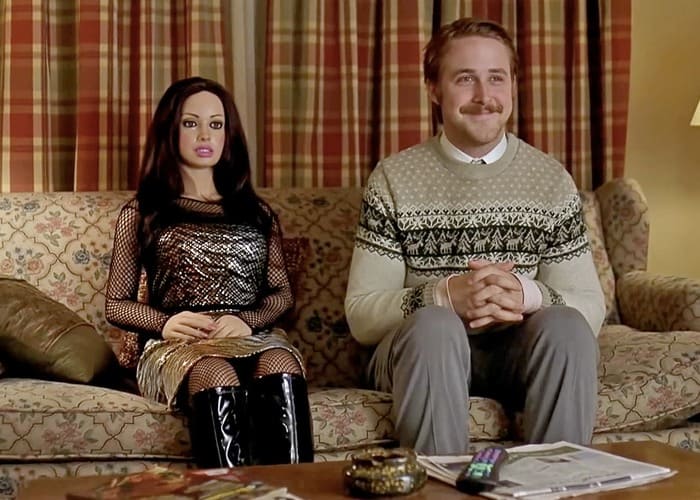
The childhood toy is a companion around which you can build a whole world. Some kids find their favorite playmates in dolls or action figures, the little plastic pieces coming to life only through imagination. They get attached and love them with everything they can, but eventually, the person outgrows the toy and moves on; it’s a rite of passage. Wouldn’t it be curious, though, if it were one that continued into adulthood?
When Lars and the Real Girl came out in 2007, it had a strange premise: a socially inept man buys a sex doll that he just wants to spend quality time with. But the film, in its portrayal of Lars (Ryan Gosling), is more interested in searching for compassion in a delicate situation than being a feature-length sex joke. Lars is painfully shy; social graces have always been beyond his grasp, though he works a full-time office job and is a regular church-goer. He lives in the garage of the house left to him and his older brother, Gus (Paul Schneider), by their late father, an emotionally withholding man, stricken by grief after Lars’ mother died giving birth to him. Gus’ pregnant wife, Karin (Emily Mortimer), makes regular attempts at coaxing Lars out of his isolation, but he politely keeps his distance, preferring self-companionship.
Until one day, when Lars hauls an anatomically-correct sex doll into Gus and Karin’s house, scaring them into thinking he’s gone insane. But Lars’ doll — her name is Bianca, and she’s a missionary of Brazilian and Danish descent, thank you very much — isn’t for sexual pleasure. Bianca goes to church with Lars. She has dinner with Lars. She sits by the lake with Lars. In turn, Lars brings Bianca to life by constructing the narrative of her humanity in his head, and justifying her inanimate disposition with a few quick explanations: she can’t walk because she needs a wheelchair, she doesn’t talk much because she’s shy, and they’re not sleeping together because she’s religious. But Bianca, silent and unmoving, manages to feel as whole as any other character by the end of the film.
Gosling is quietly revelatory in this role, acting opposite a doll and quite generously so. His Lars accommodates Bianca with brief pauses and silences, allowing the momentary gaps to be filled by what we imagine she might be saying. We can picture her in the spaces that he leaves for her mid-speech, but even more remarkable is when Lars answers Bianca, implying that she has initiated conversation herself, as any regular person might do. Sometimes, Lars is interrupted by Bianca, and Gosling perfectly encapsulates the abruptness of such an exchange. He has a clear propensity for registering physical cues without an actual human across from him; Lars blushes and stutters when “flirting” with Bianca just as easily as his face contorts in pain during their arguments.
The introduction of Bianca into Lars’ life gets the attention of the townspeople who have always watched him from a curious distance, especially his sweet colleague Margo (Kelli Garner). Concerned for him, Gus and Karin take Lars to a physician (really a psychiatrist, played by the ethereal Patricia Clarkson) under the guise that Bianca needs to have her health checked weekly. They’re advised to humor Lars’ delusion so that they might find an underlying explanation for it: “What we call a mental illness isn’t always an illness; it can be a communication, a way of working something out.” But in treating Bianca as a real person, something magical happens: it’s not that Lars’ walls are broken down, but rather like a door is gradually opened. He warms to human interaction so long as Bianca can act as a liaison between him and the people in his life.
Suddenly, almost everyone in this small town is going along with the clinically approved bit. Lars, known by neighbors for his unusual solitude, is emerging from a shell — and they accommodate his delusion because it’s understood that he has made some kind of breakthrough. Perhaps what makes this film so deeply rooted in empathy is the twofold nature of this odd exercise. Lars learns to understand and interact with other people on his terms; and by accepting his need for those conditions, the townspeople give him room to grow into the person he wants to be. The doll becomes a bridging point between Lars and the people in his life, alleviating his loneliness and giving his loved ones an opportunity to really know him, maybe for the first time ever.
And what is there to know about Lars? Well — his sister-in-law is pregnant, and thus at risk of Lars’ mother’s fate. Just as a child might make their dolls argue to mirror a schoolyard squabble, Bianca is both a response to Lars’ anxieties and a reflection of them. Toys play a crucial role in developing an emotional connection with oneself. They are companions but they can also be fantasy-fulfilling proxies: in fact, they’re a child’s first taste of freedom, enabling them to determine the trajectory of someone’s existence.
But that little piece of freedom can be taken away; you can’t be in control all the time. Lars gets angry when Bianca starts spending less time with him, and the film offers us a brief parallel, in a scene where Margo cries, her office teddy bear having been “hung” with a noose after a workplace feud. They’re both using their toys to hide hurt over different things: Lars is worried about Karin’s pregnancy, and Margo recently went through a breakup, her loneliness more potent than ever. But once their respective pain is alleviated, they will both outgrow their toys.
Just as suddenly as Bianca arrived in Lars’ life, it’s her time to leave it. It makes all the difference that the choices Lars makes for Bianca’s character aren’t treated or even written as conscious choices, but rather as the consequences of being human, which often includes bearing the brunt of life’s harshest wild card moments. Where Lars’ father turned inward to mourn, Lars turns outward, strengthened by the relationships he was able to cultivate with another person — albeit a silicone one — by his side. Lars and the Real Girl never has to rely on malice or antagonism to stir conflict. There’s enough drama in the glorious trajectory of having loved and lost: a parent, a loved one, a favorite toy.
Related Topics: Craig Gillespie, Emily Mortimer, Kelli Garner, lars and the real girl, Paul Schneider, ryan gosling

